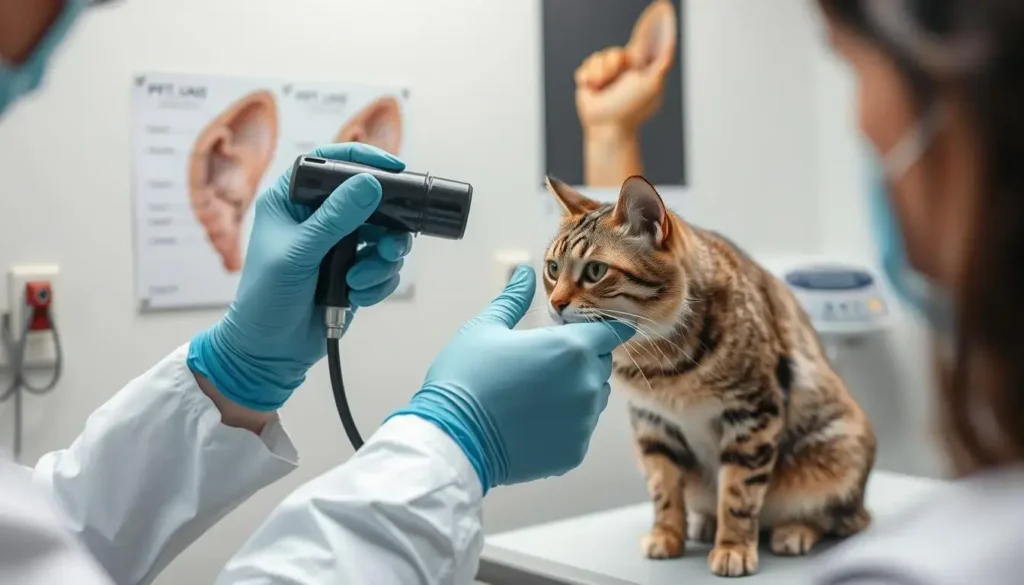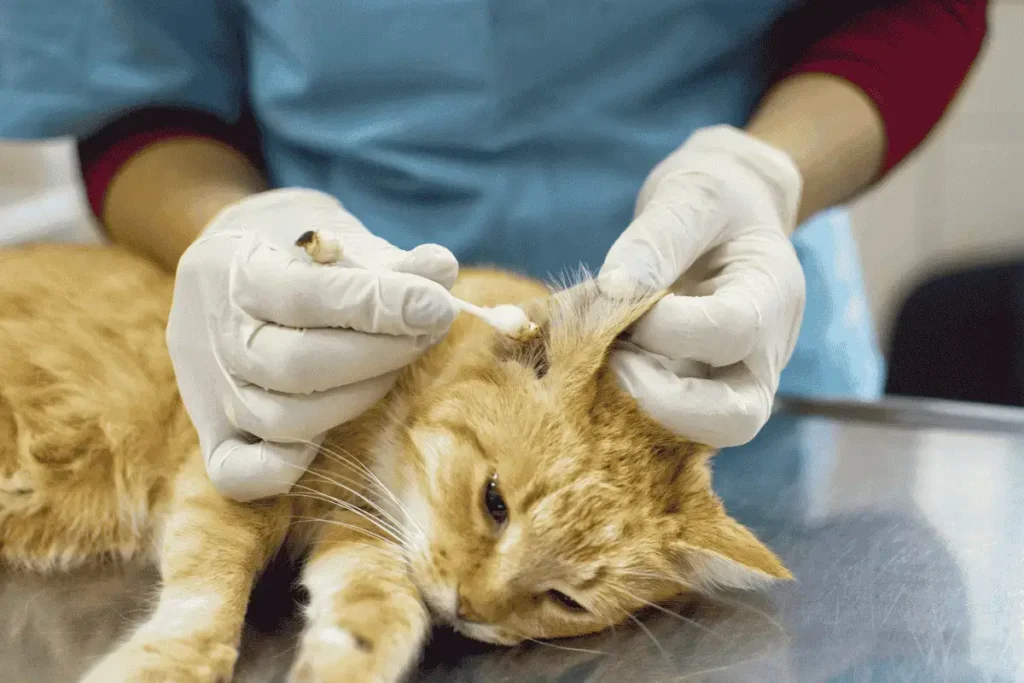How to get rid of ear mites in cats? Many cats struggle with ear mites, making it a frequent issue for pet owners. They can make your cat very uncomfortable and even lead to infections if not treated. But there’s good news – you can get rid of them and help your cat’s ears feel better. In this guide, we’ll show you how to tackle ear mites in cats.

Key Takeaways
- Ear mites, known as Otodectes cynotis, are highly contagious parasites that commonly infect cats, especially kittens and outdoor felines.
- Symptoms of ear mite infestation include intense itching, head shaking, and abnormal ear discharge.
- Quickly identifying and treating ear mites is essential to clear up the infestation and avoid any additional infections.
- Topical medications and ear cleaning are effective methods to get rid of ear mites in cats.
- Maintaining an immaculate environment and using preventative flea, tick, and heartworm products can help prevent recurrent ear mite infestations.
Understanding Ear Mites: What They Are and Why They Matter
Ear mites, known as Otodectes cyanosis, are tiny arachnids that live in cats’ ears. They cause ear infections, leading to discomfort and health problems if not treated. Knowing about ear mites helps in managing and preventing them.
The Biology of Otodectes Cynotis
Otodectes cynotis are small, eight-legged mites that live in cats’ ears. They are tiny, measuring 0.3 to 0.4 millimeters. Their oval shape and transparent look make them easier to see with a vet’s help.
Life Cycle and Reproduction
The life cycle of ear mites in cats is short, lasting about three weeks. Female mites deposit their eggs inside the cat’s ear canal, where they hatch within just four days. The larvae grow, molt, and become adults, starting the cycle again. This fast growth leads to quick infestations if not treated.
Impact on Feline Health
Ear mites are one of the top reasons cats get ear infections. They make cats uncomfortable and can cause serious problems. The mites’ actions in the ear can lead to inflammation, itching, and even damage to the eardrum if not treated.
Even if a cat doesn’t show symptoms, all pets in the house should be treated. Ear mites spread quickly between cats and dogs. Using monthly parasite preventatives is vital to keeping your pets mite-free.
Common Signs and Symptoms of Ear Mite Infestation
Ear mites, especially the Otodectes cynotis type, are common in cats. They are tiny and live in a cat’s ear canal, which is irritating. If left untreated, these mites can cause serious infections that could make your cat feel much worse.
It’s essential to spot ear mite signs early. This helps in treating them quickly and preventing worse problems.
The primary signs of ear mites in cats are:
- Excessive head shaking and ear scratching.
- Inflammation and redness in the ear
- Frequent scratching can lead to noticeable hair loss around your cat’s ears.
- Dark, crusty, or waxy discharge resembling coffee grounds in the ears
- Presence of pus in the ears
These symptoms can also mean other ear issues. So, a vet must check the cat thoroughly. They will look at the ear and use a microscope to confirm ear mites.
Cats in shelters or those often around other animals are more likely to get ear mites. It’s critical to treat them fast. This helps the cat feel better and stops the mites from spreading.
How Cats Contract Ear Mites: Transmission and Risk Factors
Ear mites, known as Otodectes cynotis, are contagious parasites. They spread quickly between cats. Direct contact with an infected cat is the primary way they are passed on.
Outdoor cats and those in multi-pet homes face a higher risk. This is because they are more likely to come into contact with infected animals.
Common Sources of Infection
Cats often get ear mites from other infected animals. This includes cats, dogs, rabbits, and ferrets. Bedding, grooming tools, and shared spaces can also carry these pests.
Newly adopted cats, especially from shelters, should be checked for ear mites. Shelters and rescue facilities are often infested with these pests.
High-Risk Scenarios for Cats
- Outdoor cats are more likely to meet infected animals and environments.
- Cats in multi-pet homes or crowded places are more at risk.
- Kittens and older cats tend to have weaker immune defenses, which leaves them more vulnerable to infections.
- Cats that go to boarding facilities, grooming salons, or shelters are at higher risk.
Ear mites can live up to a month outside a cat’s ear. This makes shared spaces and items a risk for transmission. Keeping your cat’s environment clean and getting regular vet check-ups is vital in preventing ear mite infestations.
Professional Diagnosis: What to Expect at the Vet
Diagnosing ear mites in cats needs a vet’s careful look. When you take your cat to the vet, they will use an otoscope. This tool lets them see deep into your cat’s ear to find mites or their eggs.
Your vet might also do an ear cytology test. They’ll take a sample from your cat’s ear and look at it under a microscope. This helps confirm ear mites and check for other infections.
- Thorough physical examination using an otoscope to inspect the ears
- Ear cytology test to analyze a sample of ear debris under a microscope
- Confirmation of Otodectes cynotis mites and potential secondary infections
Getting a correct diagnosis is critical for treatment. By teaming up with your vet, your cat will get the right medicine. This helps get rid of ear mites and stops more problems.

“Early diagnosis and treatment by a vet are crucial in managing ear mites and related complications.”
How to Get Rid of Ear Mites in Cats: Treatment Options
Ear mites are tiny parasites that can really bother cats. If not treated, they can make your cat very uncomfortable. Luckily, there are many ways to get rid of ear mites in cats and make their ears healthy again.
Prescription Medications
Prescription medicines are a top choice for treating ear mites treatment for cats. These medicines, like milbemycin or ivermectin, kill the mites and their eggs. Your vet will tell you which one is best for your cat.
Topical Treatments
There are also over-the-counter treatments to help get rid of ear mites in cats. These include ear cleansers like Epi-Otic Advanced. They clean out the ear canal and may have ingredients to kill mites.
Systemic Solutions
If the mites are nasty, your vet might suggest a systemic treatment. Products like Revolution or Advantage Multi are applied on the skin but work all over the body. This method can be very effective against challenging mite problems.
It’s critical to treat all pets in the house for ear mites to stop them from coming back. Your vet can help you figure out the best way to get rid of ear mites in cats and keep them away.
Step-by-Step Guide to Cleaning Infected Ears
Cleaning your cat’s ears is crucial in fighting ear mites. It removes wax and debris, helping your cat feel better. Here’s how to clean your cat’s ears the right way:
- Gather what you need: ear-cleaning solution from your vet, cotton balls, and a clean cloth or towel.
- Hold your cat’s head gently and put a few drops of ear-cleaning solution in the ear flap. Don’t push the bottle too far to avoid too much pressure.
- Massage the ear base for 20-30 seconds. This helps spread the solution and loosen dirt.
- Use an immaculate cotton ball to wipe away dirt, wax, or discharge from the ear flap. Don’t put the cotton ball in the ear canal.
- Let your cat shake their head to get rid of extra solution and dirt.
- Do the same for the other ear if needed.
It’s essential to clean your cat’s ears regularly while treating ear mites. Don’t use cotton swabs or put anything in the ear canal, as it can hurt. If you need more clarification, always ask your vet for advice.
“Cats who scratch their ears a lot may need their ears cleaned. Look for signs like fur loss, ear tearing, bleeding, or scabs.”
By following these steps, you can help your cat feel better and fight off ear mites. Remember, regular vet visits and good ear care are essential for your cat’s health and happiness.

Duration and Effectiveness of Different Treatments
If your cat has ear mites, you want them to feel better fast. The good news is that most cats can get better in just a few weeks. Knowing how long and how well different treatments work helps you set realistic goals for your cat’s recovery.
Timeline for Recovery
Treatment for ear mites usually lasts about three weeks, matching the mite’s life cycle. Cats often start feeling better in just a few days. This is because the medicines quickly kill the adult mites.
However, it takes about a month to get rid of all the mites. This is because treatments need time to kill off any eggs and young mites.
Monitoring Treatment Progress
Regular check-ups with your vet are essential when treating ear mites. Your vet will check your cat’s ears for any signs of mites. This ensures the treatment is working and makes any needed changes.
By being patient and following your vet’s advice, you can eliminate ear mites and help your cat recover. Keeping a close eye on your cat during the ear mite treatment duration is crucial for a complete recovery.
Preventing Ear Mite Reinfection in Your Cat
To keep your cat ear mite-free, you need to act early. Use monthly flea, tick, and heartworm preventatives all year. This stops ear mites and protects against other pests that carry them.
Regular ear cleaning is vital. Clean your cat’s ears weekly to remove wax and debris. Use a gentle ear cleaner and avoid over-cleaning to prevent irritation.
If your cat has ear mites, keep them away from other cats. Ear mites spread quickly, so separate infected cats until treatment is done. For outdoor cats, limit their time outside to reduce exposure.
FAQ
What are ear mites in cats?
Ear mites are tiny parasites that settle inside a cat’s ear canal, causing discomfort and potential health issues. They are common in kittens and outdoor cats. These mites cause irritation and inflammation and can lead to bacterial infections if not treated.
What symptoms of ear mites in cats?
Cats dealing with ear mites often shake their heads or scratch at their ears frequently. They might also have hair loss around their ears. You might see a dark, crusty discharge that looks like coffee grounds. Sometimes, there’s pus. They might also rub their ears on the ground.
How do cats get ear mites?
Cats get ear mites from other infected animals, like cats, dogs, rabbits, or ferrets. Outdoor cats and those with other pets are more likely to get them. Mites can also live in the environment for a month, spreading through contaminated bedding or grooming tools.
How are ear mites diagnosed in cats?
Vets use an otoscope to check a cat’s ears for mites. They might also do ear cytology to look at ear debris under a microscope. This confirms the presence of mites and eggs and checks for bacterial infections.
What are the treatment option for ear mites in cats?
Treatment includes ear drops like milbemycin or ivermectin and systemic treatments like Revolution or Advantage Multi. These kill mites. Ear cleansers like Epi-Otic Advanced remove debris. For bacterial infections, antibiotics might be needed. In severe cases, steroids might be prescribed.
How do I clean my cat’s ears to treat ear mites?
Use a vet-prescribed ear cleanser to clean infected ears. Gently massage the ear base for 20-30 seconds. Take a cotton ball or some gauze and gently wipe away any dirt or buildup from the ear flap. Never put anything into the ear canal. Regular cleaning helps remove wax and debris, reducing mite numbers and aiding recovery.
How long does it take to get rid of ear mites in cats?
Treatment for ear mites usually lasts three weeks, matching the mite’s life cycle. Cats often start feeling better within a few days. But it takes about a month to eliminate mites. Regular vet visits are essential to ensure mites are gone.
How can I prevent ear mite reinfection in my cat?
Prevent reinfection by using monthly flea, tick, and heartworm preventatives. Clean your cat’s ears weekly to prevent mite buildup. Keep infected pets separate from healthy ones until treatment is done. Limit outdoor time for outdoor cats. Constant vet visits can catch early signs of infestation.

Pingback: Top Symptoms of Ear Mites in Cats and How to Identify Them
Respected point of view